뉴스&스피킹(영자신문)
하루 10분이면 영어에 대한 두려움을 극복하고 누구나 유창하게 영어를 구사하실 수 있습니다.
-
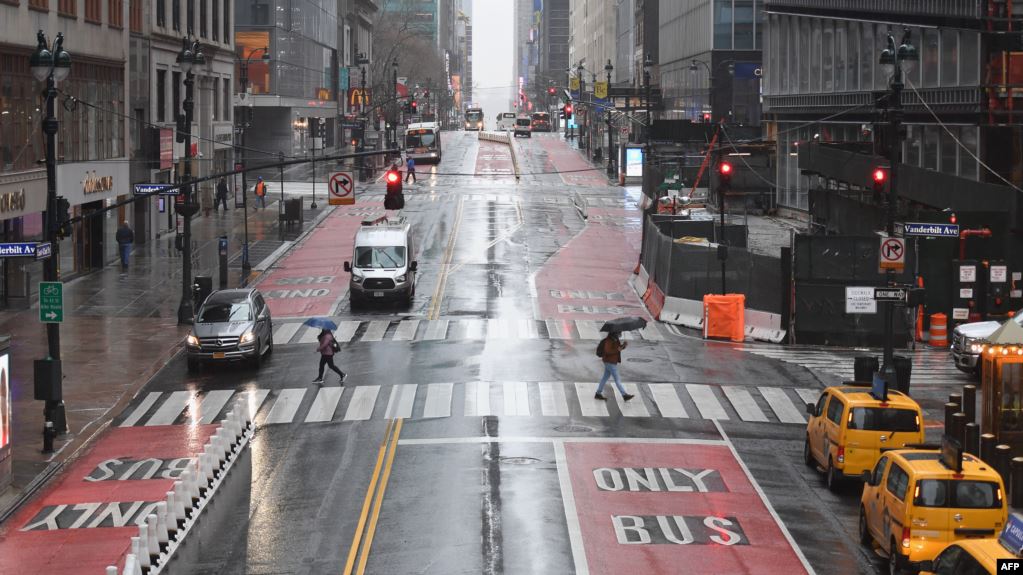 The Economy Shrinks with Shocking Speed Three weeks ago, the car service company EmpireCLS was heading toward its second straight year of a growing business. Empire, based in New Jersey, could not find enough drivers and office workers to meet its needs.
The Economy Shrinks with Shocking Speed Three weeks ago, the car service company EmpireCLS was heading toward its second straight year of a growing business. Empire, based in New Jersey, could not find enough drivers and office workers to meet its needs.
Now, the company is on the edge of failure.
With extreme speed, business in the United States and around the world has collapsed in the face of the coronavirus. People are told to stay home. A car service like Empire is not needed.
The company has had a “90 percent revenue loss in three weeks,” said company chief David Seelinger. “We’ve been through 9/11. We’ve seen recessions. We’ve never seen anything like this.’’
Seelinger spent last Sunday telling 750 of his 900 employees they no longer had a job.
“It was the most difficult day of my career,” he said.
Never before has the American economy come to such a sudden, violent stop. The fall has shocked Americans who had enjoyed more than 10 years of a growing job market and economy. Now, the economy is headed toward a deep recession. Millions of people will likely lose jobs within a few months.
“The economy has never gone from healthy to disaster so quickly,” said Jason Furman. He was former President Barack Obama’s top economic adviser and is now a professor at Harvard’s Kennedy School.
“What would take years in a financial crisis has happened in days in this health crisis,’’ Furman said.
Since the Great Recession ended in 2009, the economy has risen for 11 years. Yearly growth has been at about 2.3 percent since 2010. Employers have added positions for workers for the last nine years.
Just two weeks ago, the government released a great employment report: A gain of 273,000 jobs in February. The country was experiencing a 50-year low in the rate of unemployment: 3.5 percent.
People were buying goods, eating out and spending money in other ways, too. Things were great.
But all that went away after just a few weeks of the spread of the new coronavirus in America.
The investment bank and financial services company Goldman Sachs says it expects the economy to shrink at a 24 percent yearly rate between April to June. Days earlier, the company had predicted a drop of just five percent during the same period.
The information services company IHS Markit predicts 7 million job losses from April to June. It expects unemployment will rise to 8.8 percent in the final three months of 2020. Some economists say it will go even higher.
As investors began to understand the seriousness of the crisis, they began to sell. Since February 12, the Dow Jones Industrial Average has fallen 35 percent. The market events have sharply reduced family wealth and consumer confidence.
“I’m not sure that anyone honestly has any sense of how this… resolves,” said Daniel Feldman. The former U.S. ambassador advises large international companies for a Washington, D.C.-based law firm.
Government officials are trying to help. The central bank has cut its main interest rate to almost zero. It is also trying to make certain that companies can use short-term credit so they can continue to pay employees. Congress and the White House are preparing a large stimulus program that includes giving money to citizens.
Economists do not usually recognize a recession until long after it has begun. Now, they can see it coming.
“Never…have I known the week a recession started,” said Diane Swonk, chief economist at the company Grant Thornton. She says the downturn began in the first week of March as the economy all but stopped.
For now, some Americans are working from home and keeping their jobs. Some of them may be saving money, which will help the economy later, explained Scott Hoyt, an economist at Moody’s Analytics.
Yet the future does not look promising. About 60 percent of American workers--82 million people--are paid by the hour. Most will not be paid if they cannot go to work.
I’m Jill Robbins.View -
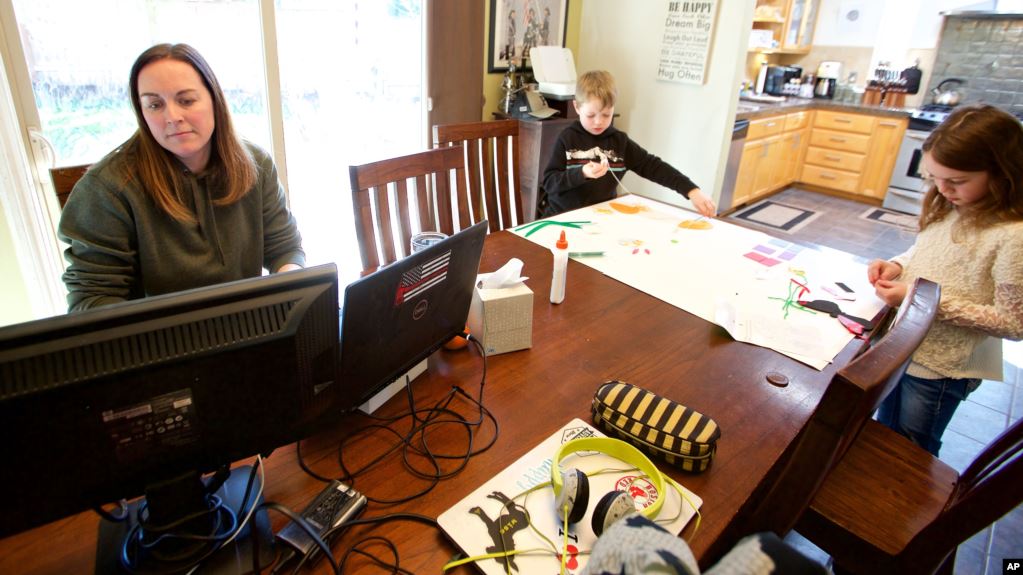 New Reality of Working From Home Mixing work and home lives has rarely been easy.
New Reality of Working From Home Mixing work and home lives has rarely been easy.
But measures to contain the virus have brought those worlds together, suddenly and sharply. Office workers, educators and many others around the world are dealing with the new reality of where they work—at home.
People are moving their work from offices to their living rooms, extra bedrooms, kitchens and basements. Young children may be running around the house while parents try to hold business meetings and students attend classes online. This huge, unplanned social experiment can hurt productivity and peace at home.
The coronavirus crisis is also forcing many parents into unexpected new jobs. Carmen Williams is a therapist in Macomb, Michigan. She finds herself seeing her patients only irregularly. When she does, she also has to pay for someone to watch her children. Meanwhile, she is also paying for her two children’s school bills, while still teaching them school assignments.
“I’m not an educator!” Williams said. “I’m used to helping with homework,” but she adds, she cannot teach long lessons and work. It’s overwhelming!”
In the United States, this experiment is moving faster because of the growing number of states ordering residents to stay home. It could affect how the country makes it through an economic recession likely to come.
Many phone and cable companies have agreed to provide open use of the Internet for the public. And technology companies are increasing their ability to handle more data—information—from all the new workers and students who must work from home.
Kelly Steckelberg is chief financial officer for the video conference company Zoom. She said Tuesday mornings used to be the busiest time for video conferencing—where people in different places can see each other on their computers or mobile phones. Now the demand for these meetings, with increased data usage, is going on all the time. Steckelberg said the company has moved up the opening of two new U.S. data centers to meet the demand.
Cisco, which runs the Webex video conference service, said it has prepared itself for on-going high demand in the U.S. This comes after they have already dealt with a 100-percent increase of data usage in Asian countries including China, Japan and South Korea.
Microsoft asked 50,000 of its own employees to work from home in the Seattle region. The company has seen large demand increases for its workplace communications service known as Teams.
Experts have said data systems are more than able to handle the big increase in demand. But people who have to stay home have still found it a struggle to stay connected with friends and family.
In the Netherlands, a team of data scientists led by Jeroen Baas has been communicating regularly with workers in different countries. But having to leave their Amsterdam office presents new difficulties with personal connection. So Baas started a 15-minute virtual—or online—meeting for workers just to talk with each other.
“It gives some time and space to talk about work or take your mind off other things, or maybe rant about what’s going on with the virus spread and people hoarding things,” he said.
Kate Darling is a researcher from the Massachusetts Institute of Technology. She is worried that she and other researchers can not use their laboratories and other important tools while working from home. Her young child has been watching television programs, “Otherwise we wouldn’t get anything done,” she said.
It is harder for Catharine Bouchard. She works for a bank in Ontario, Canada. With two young children, ages 4 and 10, she says she cannot center her thoughts on work. She says, she is worried.
I’m Bryan Lynn.View -
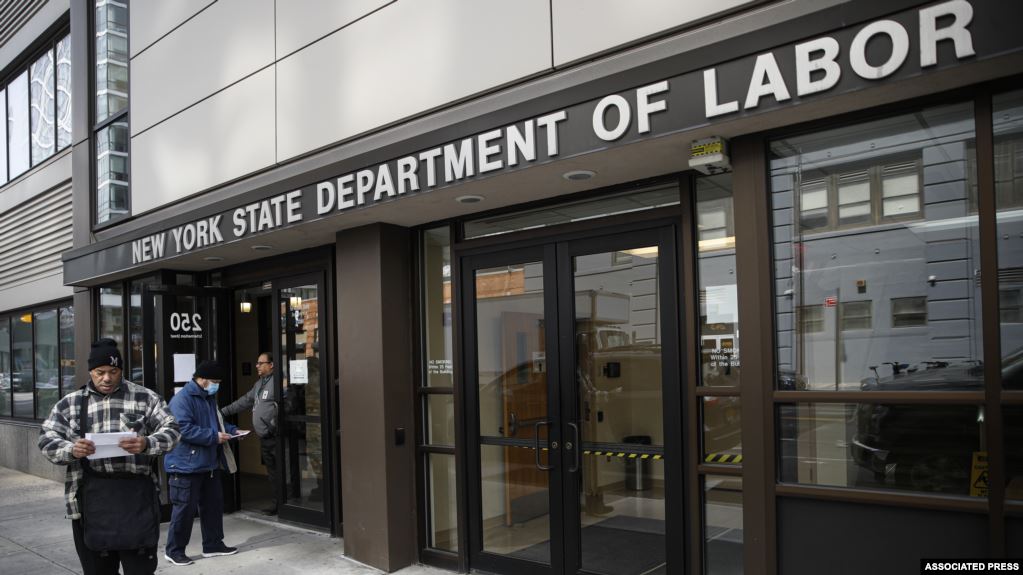 Millions Unemployed as Central Bank Warns US in 'Recession' More than 3 million jobless Americans asked the United States government for financial assistance last week.
Millions Unemployed as Central Bank Warns US in 'Recession' More than 3 million jobless Americans asked the United States government for financial assistance last week.
That is a record number for one week, the U.S. Labor Department reported Thursday. The old record had been 695,000 from 1982.
This is the beginning of the really bad numbers we are going to see for the next few months, said Subadra Rajappa. She is head of U.S. Rates Strategy at Societe Generale in New York City.
Also on Thursday, the chairman of the Federal Reserve, Jerome Powell, told NBC television that “the U.S. may already be in recession,” as many companies have suspended operations. Schools, movie theaters and other businesses have closed as Americans turn to social distancing to slow the growth of coronavirus.
The central bank chair added that progress in controlling the spread of the coronavirus will decide when the economy can fully reopen.
Wednesday night, the U.S. Senate approved a $2 trillion bill to help people and businesses during the coronavirus pandemic. The measure is the largest stimulus bill in American history. The House of Representatives is expected to pass it on Friday.
Once signed into law, it will provide direct payments to many Americans as well as provide money to businesses that are hurting.
Lawmakers hope the bill will prevent the economy from heading into a long economic depression, such as the one the United States experienced in the 1930s.
U.S. President Donald Trump said this week that he would like to see Americans go back to work by Easter, April 12. He suggested that efforts to slow the virus may no longer be needed at that date. However, several companies and business groups are listening to health officials who say Americans need to stay home for a much longer amount of time.
“We urge all businesses and the public to listen to public health officials when it comes to social distancing,” says Neil Bradley of the U.S. Chamber of Commerce.
But some business leaders agree with the president. Former Goldman Sachs Chief Executive Officer Lloyd Blankenfein wrote: “Crushing the economy, jobs and morale is also a health issue.” His comments appeared on Twitter.
The Ford Motor Company announced Thursday it will open its factories as early as April 6. Ford said it will include “new safety measures” for its workers.
In Europe, government officials and industry leaders are still discussing the need for a full shutdown. Italy, which has the most coronavirus deaths of any country, is adding new restrictions. French President Emmanuel Macron has urged some workers to continue reporting to work. Spain is in a complete shut down. The country has the second largest number of deaths from the virus, more than 4,000.
In China, where the virus was first identified three months ago, economic conditions are just beginning to improve.
In the United States, New York City is now the epicenter of the virus. New York has more than 17,000 confirmed coronavirus cases. Hospitals in the city are running out of room to store the bodies of the dead, one worker told news organizations.
New York State Governor Andrew Cuomo said Wednesday the peak of the infection is still about three weeks away. He said he expects as many as 140,000 cases and nearly 40,000 people will need hospitalization.
I'm Bryan Lynn.View -
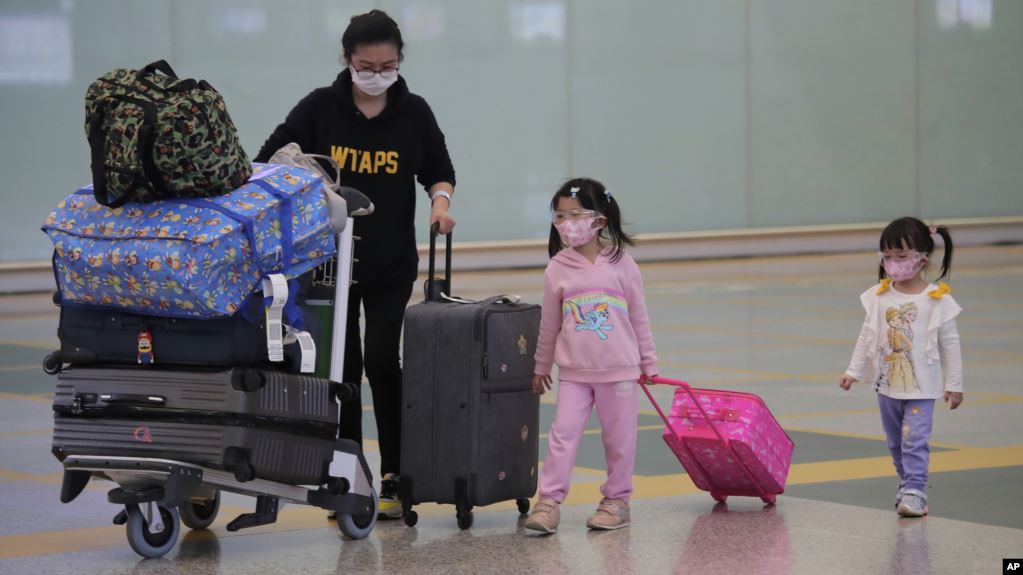 Returnees Increase Asian Nations’ Coronavirus Infections People returning from Western countries are bringing a new wave of coronavirus cases to parts of Asia such as Hong Kong and Taiwan.
Returnees Increase Asian Nations’ Coronavirus Infections People returning from Western countries are bringing a new wave of coronavirus cases to parts of Asia such as Hong Kong and Taiwan.
This is happening as health officials in the area were getting their outbreaks under control.
The development, which health officials describe as “imported cases,” threatens disease control work and economic recoveries.
“Once they’re overseas, situations easily develop,” Taiwan health and welfare Minister Chen Shih-chung said this week. “However, (returnees) have the right to live here, so if they have any symptoms, we do our best to intercept them at the airports.”
Flights to East Asia being watched
Chen said people arriving from heavily infected places such as Western Europe and the United States brought many new cases last week. The Taiwan Centers for Disease Control said most of the new cases reported earlier this week had come to the island from other countries.
The total number of cases in Taiwan has grown nearly five times since early March.
Late last week, Hong Kong recorded 48 cases in one day resulting in warnings there about arrivals from overseas.
Singapore had contained its outbreak, one of the world’s earliest. However, people returning from overseas have pushed the total caseload higher. Singapore’s Ministry of Health said many of the new cases were imported local media reported.
People are returning to Taiwan from overseas for several reasons, including school cancellations, Taiwanese health minister Chen said. Those returns will continue for another two weeks, he predicted, before everyone gets back. The daily number of people entering Taiwan is decreasing and totaled about 4,600 early this week.
Bans on foreign visitors
Taiwan, Singapore, Malaysia and Vietnam have all banned most foreign visitors. Taiwan took the extra step Sunday of barring transit passengers. Quarantine rules have been strengthened on arrivals with any kind of passport. People arriving in Hong Kong from anywhere in the world are ordered to quarantine. Taiwan asks airplane passengers to report travel histories and any clear symptoms.
Most airplane passengers are returning home as few people are starting trips, said Brendan Sobie. He started the Singapore-based advising company Sobie Aviation.
“What will happen in Singapore and Taiwan and Hong Kong will depend on the cases that came from abroad,” said Rajiv Biswas, Asia-Pacific chief economist at the information services company, IHS Markit. “If it can be kept under control for the next couple of weeks, then hopefully things should get better,” he said.
Economic recovery could be affected
In China, where the virus spread began, citizens have slowly returned to work this month. People have started going out to eat again and to visit stores. In Taiwan, children are still attending school, workplaces remain open and restaurants are filled on weekends.
But experts warn that bans on foreign travel into Asian countries will reduce how much people spend there, especially in the case of foreign travelers. For example, Vietnam's normally active tourism industry is almost completely quiet. The country reported a few imported coronavirus cases this month. There are more than 230 confirmed cases there.
Adam McCarty is chief economist with advisory company Mekong Economics. He said travel bans mean little economic improvement can be made.
“If people can’t travel from one country to another, then demand will not pick up no matter how much money you throw at the problem, so it’s really different (from) just a normal downturn,” McCarty said.
Mario Ritter Jr. adapted the VOANEWS report for VOA Learning English. Caty Weaver was the editor.View -
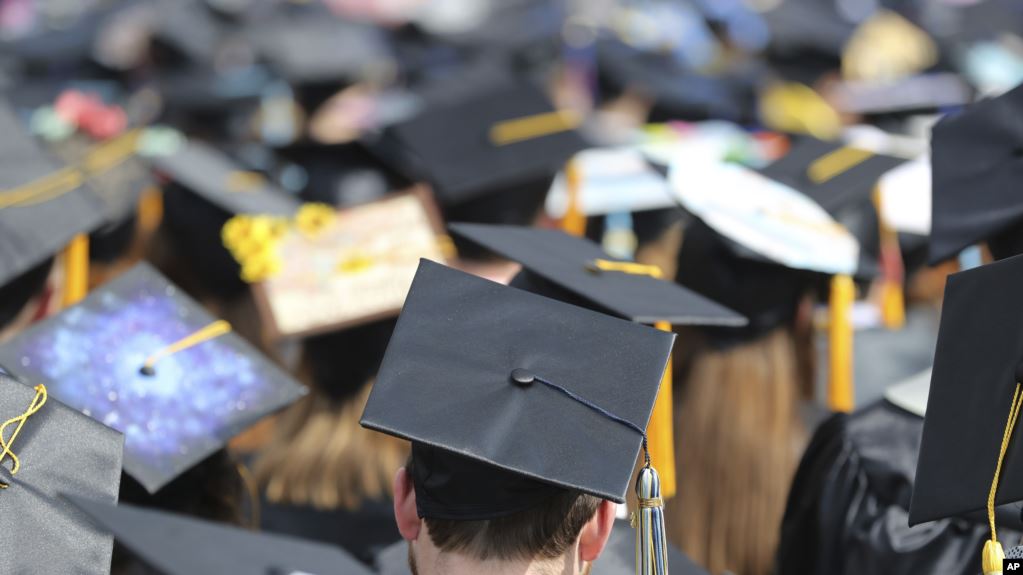 US College Completion Rate Rises, As Ceremonies Are Postponed This year, many students who are graduating from universities across the United States and in many countries will not get to enjoy traditional celebrations of their success.
US College Completion Rate Rises, As Ceremonies Are Postponed This year, many students who are graduating from universities across the United States and in many countries will not get to enjoy traditional celebrations of their success.
A growing number of schools are cancelling or postponing their graduation ceremonies because of the worldwide spread of the coronavirus.
But in the U.S., the cancellations do come at a time when the national graduation rate is continuing to increase.
Mikyung Ryu is the director of research publications for the National Student Clearinghouse Research Center. She told VOA that for a long time, the national rate of completion for two and four-year college study programs stayed a little over 50 percent.
The U.S. Department of Education reports the nation’s graduation rate. But, Ryu said it has not been getting the full picture of who actually was entering higher education. She noted that the agency was not including in its numbers students who left college to study at different schools. Also, many older students and ones working full-time jobs have started attending colleges and universities in recent years. These people are often unable to complete their programs in the usual two or four years.
“The traditional measure of college completion outcomes does not work well anymore. So it has to be adjusted to better address the increasingly complex student profile,” said Ryu.
So in 2009, the National Student Clearinghouse Research Center asked over 3,600 colleges and universities in 45 states for more complete student data. For students in two-year programs, the group looked at how many students graduated within three years. For four-year programs, it looked at the six-year graduation rate. The center also included information on students who moved from one school to another to continue their education.
Last December, the center released a comparison between the six-year graduation rate for all students who started in the fall of 2009 to those who started in the fall of 2013. Researchers found the overall graduation rate had increased to 60 percent.
Ryu said the results represent a nationwide success story because gains were found in 43 out of 45 states.
Yet experts like Iris Palmer say the national graduation rate does not tell the whole story. She is a top advisor for higher education and the workforce at New America, a public policy research group.
She noted that, because of the rising cost of higher education in the U.S., many schools are under pressure to show their success in both completion and job placement. In addition, some colleges and universities might admit only the highest performing candidates in order to increase their completion rates.
“If you become more selective, you’re more likely to have a higher graduation rate,” Palmer said. “So the worry is that if you focus too much on the graduation rate, you disadvantage low-income and historically discriminated against populations, because it is actually harder to get them to graduate.”
Still, Palmer notes schools and policymakers have made an effort to improve student success. This includes measures to improve guidance for students through their programs, as well as other support services.
Josh Wyner agrees that overall this seems to be a sign that American higher education is moving in the right direction. He is the executive director of the College Excellence Program at the Aspen Institute. But he notes 60 percent is still low and it is not clear what this number means for the future.
There is still more to be done that can increase the rate, Wyner argued. This includes exploring new teaching methods, and increasing efforts to make all students, especially non-traditional ones, feel like they belong at colleges and universities. It also means including different kinds of study programs in this count.
“The credentials that matter are the ones that enable somebody to get a good job … regardless of whether that’s technical training or traditional liberal arts,” Wyner said.
I’m Pete Musto.View

